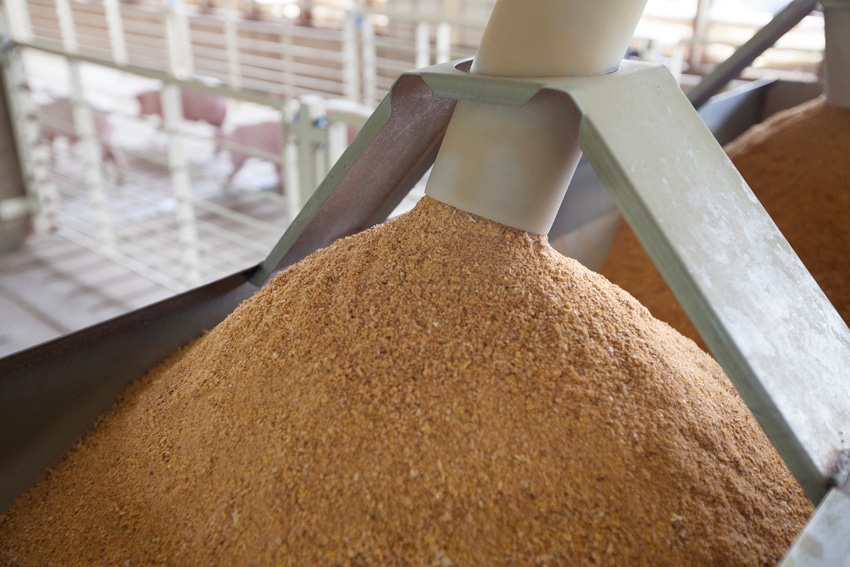Research shows increasing soybean meal can optimize final BW and improve F/G.
September 9, 2021

Soybean meal is a commonly used protein source in swine diets due to its availability, amino acid profile and digestibility. However, it is common for swine diets to be formulated with increasing amounts of feed grade amino acid and grain co-products such as dried distillers grains and wheat midds to replace soybean meal if economics allow. Thus, diets for late-finishing pigs may contain very little, if any, soybean meal depending on the combination of other ingredients utilized in the diet.
Although dietary amino acid requirements may be met, swine diets with low amounts of soybean meal typically contain crude protein concentrations below the established recommendation of 12-13% for late-finishing pigs, which can compromise growth performance. Therefore, the objective of a combined three experiments involving 4,406 late-finishing pigs was to determine optimal levels of soybean meal needed to optimize growth performance of finishing pigs from 220 lbs. to market under different formulation strategies.
In Experiment 1, a total of 1,793 pigs (L337 × 1050, PIC, Hendersonville, TN; initially 231.2 ± 2.4 lbs.) were used to evaluate the effects of increasing soybean meal in corn-based diets on growth performance of late finishing pigs. Pens of pigs were blocked by initial weight and randomly assigned to one of five dietary treatments with 22-25 pigs per pen and 12-14 pens per treatment. Experimental diets were corn-based, formulated to 0.70% SID Lys, and contained varying amounts of feed grade amino acids to meet or exceed requirement estimates. Soybean meal gradually increased from 5% to 20% of the diet and replaced feed grade amino acids. Thus, experimental diets contained 9.6, 10.8, 12.0, 13.4, or 14.7% crude protein. Pigs were weighed to evaluate ADG, ADFI, and F/G. Overall, pigs fed increasing soybean concentrations in the late-finishing period exhibited increased ADG (linear and cubic, P < 0.05), and improved F/G (linear and cubic, P < 0.05). The greatest improvements were observed as dietary soybean meal increased from 5% to 8.75% and from 16.25% to 20%. Additionally, final BW of pigs increased (cubic, P < 0.05) as soybean meal increased from 5% to 8.75% and from 16.25% to 20%. Although diets were formulated to exceed the minimum NRC (2012) nutrient requirement estimates, we suspect the observed response may be due to the increased Trp:Lys ratio of 21.6 in the 20% soybean meal diet compared to 20% in all other diets. These results suggest that at least 8.75% soybean meal should be utilized to increase dietary crude protein content beyond 11% to improve growth performance of late-finishing pigs in corn-based diets.
In Experiment 2, 1,827 pigs (L337 × 1050, PIC; initially 215.8 ± 2.5 lbs.) were used to evaluate the effects of increasing soybean meal in corn-DDGS-based diets on growth performance of late finishing pigs. Pens were blocked by body weight and randomly assigned to 1 of 5 dietary treatments with 14 replications per treatment. Experimental diets were corn-based with 25% DDGS. Soybean meal levels increased from 0% to 16% in 4% increments replacing added feed grade amino acids. Overall, final body weight of pigs marginally increased (quadratic; P < 0.10) as soybean meal increased, with the greatest improvement observed when diets contained 8% soybean meal. However, there were no differences among treatments in overall ADG, ADFI, or F/G. Furthermore, there was no influence of increasing soybean meal on carcass characteristics. These results suggest that increasing soybean meal concentrations in diets that contain 25% DDGS did not influence growth performance of late-finishing pigs, however, 8% inclusion of soybean meal did provide the highest final BW and lowest F/G in this study.
In Experiment 3, 786 pigs (PIC TR4 × (Fast LW × PIC L02); initially 213.2 lbs. ± 2.37 lbs.) were used to evaluate the effects of increasing soybean meal in corn-wheat midds-based diets on growth performance of late finishing pigs. Pens of pigs were blocked by body weight and randomly assigned to one of five treatments with nine replications per treatment. Experimental diets were corn-based with 30% wheat midds. Soybean meal levels increased from 0% to 16% replacing added feed grade amino acids. Overall, final body weight of pigs increased (linear, P < 0.05) as dietary soybean meal increased. Additionally, overall ADG and F/G improved as soybean meal increased (linear and cubic; P < 0.05) with no differences in overall ADFI. Although diets were formulated to exceed minimum NRC (2012) nutrient requirement estimates, we suspect that the increased Trp:Lys ratio in the 16% soybean meal diet may explain the cubic responses observed. These results suggest that corn-soybean meal-based diets with 30% wheat midds for late finishing pigs should contain at least 4% soybean meal.
To conclude, these results suggest that when grain co-products are not included in the diet, at least 8.75% soybean meal and dietary crude protein levels beyond 11% are necessary to optimize growth of late-finishing pigs. Furthermore, although increasing soybean meal did not influence overall growth, 8% inclusion of soybean meal can optimize final BW and improve F/G of pigs fed diets with 25% DDGS. Finally, corn-soybean meal-based diets with 30% wheat midds should contain at least 4% soybean meal to improve overall growth and final BW of late-finishing pigs
This data will be discussed more in-depth at the 2021 K-State Swine Industry Day on Nov.18.
The authors wish to thank the United Soybean Board for partial financial support of this research.
Sources: Julia Holen, Robert Goodband, Mike Tokach, Jason Woodworth, Joel DeRouchey, Kansas State University, who are solely responsible for the information provided, and wholly own the information. Informa Business Media and all its subsidiaries are not responsible for any of the content contained in this information asset.
You May Also Like



